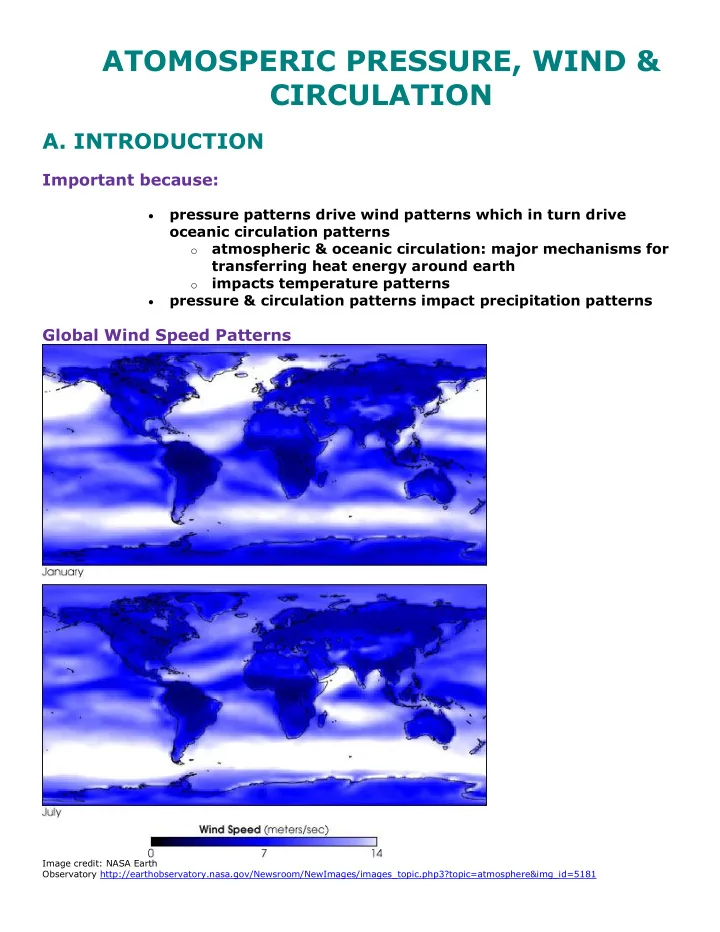

ATOMOSPERIC PRESSURE, WIND & CIRCULATION A. INTRODUCTION Important because: pressure patterns drive wind patterns which in turn drive oceanic circulation patterns o atmospheric & oceanic circulation: major mechanisms for transferring heat energy around earth o impacts temperature patterns pressure & circulation patterns impact precipitation patterns Global Wind Speed Patterns Image credit: NASA Earth Observatory http://earthobservatory.nasa.gov/Newsroom/NewImages/images_topic.php3?topic=atmosphere&img_id=5181
Learning Outcomes By the end of this unit you should be able to: describe the impact of pressure, density, and Coriolis on surface winds, and illustrate the horizontal and vertical wind flow patterns in cyclones and anticyclones; diagram global pressure and wind patterns and describe the seasonal shift in global pressure and wind; distinguish land breezes from sea breezes, and winter monsoon winds from summer monsoon winds, and explain when and why they occur; diagram the large scale ocean circulation patterns in the northern and southern Atlantic and Pacific oceans and relate oceanic circulation patterns to atmospheric circulation patterns. B. DENSITY AND PRESSURE Atmospheric pressure force exerted by the atmosphere on a surface measured in millibars or hectopascals (1 mb = 1 hPa); isobars pressure differences cause wind to blow o wind direction: wind blows from high to low pressure o wind speed: the steeper the pressure gradient, the faster the wind speed determined by density Density number of molecules per some volume of space air temperature impacts density & thus pressure o differences in temperature create differences in pressure o warm air less dense than cold air at the same altitude o warm air rises; cold air sinks altitude impacts density & thus pressure o as altitude increases, density decreases o air at higher altitudes always less dense than air at lower altitudes regardless of temperature vertical air flow impacts density & thus pressure o rising air always associated with low pressure regardless of temperature o sinking air always associated with high pressure regardless of temperature
C. CORIOLIS deflection due to rotation of earth deflection to right in northern hemisphere when looking down the pressure gradient deflection to left in southern hemisphere when looking down the pressure gradient magnitude of deflection greatest at poles, least at equator result: o cyclones: low pressure centers counter clockwise rotation clockwise rotation
Tropical cyclone Kujira 2003 Tropical cyclone Ingrid 2005 Image credit: NASA Visible Image credit: NASA Visible Earth http://visibleearth.nasa.gov/view_rec.php?id=8 Earth http://visibleearth.nasa.gov/view_rec.php?id=53 25 o anticyclones: high pressure centers clockwise rotation counterclockwise rotation
D. GLOBAL PRESSURE AND WIND PATTERNS
Intertropical Convergence Zone (~0-10 o ) winds blow into low pressure regions Trade winds Subtropical high pressure cells (~20-40 o) winds blow out of high pressure cells Trade Winds toward Equator Westerlies toward Poles Subpolar low & Polar front (~40-70 o ) winds blow into low pressure region Westerlies Polar Easterlies Polar high winds blow out of high pressure cells Polar Easterlies
E. LOCAL AND REGIONAL WINDS Land and sea breezes Sea breeze Land breeze Monsoon winds in Southeast Asia Winter monsoon Summer monsoon
F. OCEANIC CIRCULATION PATTERNS East coasts: warm ocean currents West coasts: cold ocean currents G. SUMMARY density & pressure differences cause winds to blow from high to low; pressure differences related to temperature, altitude, and vertical air motions o low pressure associated with warmer air, higher altitudes, and rising air o high pressure associated with cooler air, lower altitudes, and sinking air coriolis causes winds to curve, which results in cyclones & anticyclones global pressure patterns from Equator to Poles: low - high - low - high global wind belts from Equator to Poles: trade winds, westerlies, polar easterlies global pressure & wind shift with the direct rays of the sun
land breezes & winter monsoon bring dry weather - high pressure over land; sea breezes & summer monsoon bring wet weather - high pressure over ocean oceanic circulation driven by subtropical high pressure cells resulting in warm ocean currents off east coasts and cold ocean currents off west coasts of continents
Recommend
More recommend